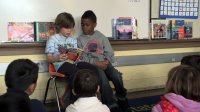Dialogue Circles and Positive Classroom Culture
As an element of restorative justice, dialogue circles foster a safe space for open discussion.
Your content has been saved!
Go to My Saved Content.Overview
Promoting Positive Behavior
Dialogue circles are gatherings in which all participants sit in a circle facing each other to facilitate open, direct communication.
Dialogue circles provide a safe, supportive space where all school community members can talk about sensitive topics, work through differences, and build consensus.
At Glenview Elementary School, circles are part of a program called Restorative Justice, which is aimed at building collaboration, respect, and positive behavior among students. The circles were implemented in classrooms slowly, and after two years, there was a marked improvement in classroom behavior.
How It's Done
Starting the Day on a Positive Note
Dialogue Circles were put to use in classrooms at Glenview after the teachers had experience using the technique with their peers. When first implemented, feedback and support from the SEL counselor was provided.
After two years, the school experienced a discipline shift as staff worked together to address misbehavior through community-building instead of punishment.
Check-In Circles
Check-In circles are a great way to start the day by inviting students to share their feelings and listen to others.
- Teachers should include themselves in the circle to signal that they are facilitators and listeners during these gatherings, not authority figures.
- Use a “talking piece” to remind students to pay attention to the speaker and that only one person talks at a time.
- Mindfulness exercises help release tension and build focus on the present moment.
- Devote at least five minutes to circle time; you can gradually expand, as students get more comfortable.
- Always allow students to opt out if they choose.
Sample Activities to build comfort and trust:
- On a Scale of 1 to 5: Ask each student to rate how she is feeling on a scale of one to five, where a “five” might signal an upcoming birthday, and a “one” might mean troubles at home. Start the activity by sharing how you are feeling and why.
- You’re in My Boat: Have a student share something personal, such as an experience or something he is interested in by saying, “You’re in my boat if…” For example, “You’re in my boat if you like French fries,” or “You’re in my boat if someone got upset with you this morning.” All who agree with the statement get up and change seats; the others remain seated.
Peacemaking Circles
Peacemaking circles can be used to help resolve conflicts between individuals or to address academic issues. Conflict resolution circles focus on restoration in lieu of punishment and their goal is to repair harm, support relationships, and solve problems.
- Encourage students to reach out to teachers when they have a problem.
- To start the circle, establish who initiated the circle and ask students if they know why they are there.
- Define the issue, starting with the student who initiated the circle. Focus on raising awareness of each student’s feelings and perspectives.
- Ask questions that emphasize choices and how choices relate to students’ values.
- Encourage students to share at least one positive thought about the student they are in conflict with.
- Ask the student who was harmed what would help them feel better.
Academic Intervention Circles
Academic intervention circles give students an opportunity to voice their needs, and help teachers and administrators understand the issues students are grappling with.
- Include family members, teachers, counselors, and/or administrators to develop strategies that address the student’s academic and emotional needs, such as one-on-one tutoring or home visits.
- Keep track of at-risk students, including their issues and the circle of individuals who are coordinating supports for them, to be sure they are getting the help they need and are making progress.
Resources
- Dialogue Circles: An Overview
- Circle Keeper's Handbook
- Oakland Unified District’s Circles Postcard
- Handbook: Stress-Reduction Activities for Students
- Effective Communication and the School Community
- Bullying Newsletter for Parents
- Healthy Boundaries, Healthy Children
- Positive Responses to Student Misbehavior
- PBIS: Positive Behavior and Intervention Support
- Restorative Justice at Glenview: A Primer for Parents
- Oakland Unified District Restorative Justice in Schools
Glenview Elementary
Enrollment
534 | Public, UrbanPer Pupil Expenditures
$7625 School • $17283 District • $13658 StateFree / Reduced Lunch
35%DEMOGRAPHICS:
58% English Language Learners
